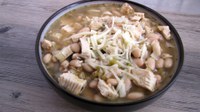Prairie Fare: Electric Pressure Cookers Can Speed Meal Preparation
(Click an image below to view a high-resolution image that can be downloaded)
By Julie Garden-Robinson, Food and Nutrition Specialist
NDSU Extension Service
“Are you enjoying your coffee?” my husband asked our 19-year-old daughter.
“Please stop spying on me!” she exclaimed as she opened the front door of our home. She was not impressed with her parents.
“I could turn off the lights in the house now,” my husband said to me a little mischievously.
“No, we better leave her alone,” I responded.
We were viewing a video of her on our phone when she was entering our front door with a cup of coffee from her favorite spot. We were more than 1,000 miles away on a trip out of state, and she was in charge of our home.
Thanks to my husband’s new interest in all things “technological,” we are able to monitor almost everything in our home, turn on the lights and get immediate answers to questions by asking an internet-connected device.
The technology available reminds me of some early TV shows about space travel, robots and kitchen conveniences. I remember Rosie the Robot, who was the housekeeper on “The Jetsons” cartoon.
I bought a robotic vacuum cleaner for Christmas.
Our kids actually were impressed with this time-saving device because we don’t ask them to help clean the floors as often. However, our dogs followed it around and “chased” it out of the kitchen and into the living room.
Along with the robotic vacuum, I bought an electric pressure cooker. I am quite impressed with this time-saving device, especially when my husband surprises us with dinner.
Pressure cookers are not new devices. They were invented in 1679 by Denis Papin, a French physicist. When you increase the pressure, you raise the boiling point of water and can cook food quickly. In the case of pressure canning, you can inactivate bacteria and their spores.
Papin called the item a “digester” because of its rapid-fire cooking. However, the early pressure cooking devices were prone to explosions.
Fortunately, many improvements in the design have been made, including pressure-release valves that prevent dinner from landing on your ceiling and walls.
I recall the jiggling and hissing sound of the stovetop pressure cooker that greeted me after school when I was in grade school. The sound usually meant that homemade vegetable soup was for dinner.
When we used our electric pressure cooker for the first time, I was surprised that it made no sound.
Electric pressure cookers, also called instant pots or multicookers, are a hot seller on today’s market, and many models are available. They vary in price, size and function. If you are thinking about getting one, be sure to check out the reviews and consider your budget.
I have a big note of caution to share. Some of the devices provide directions for pressure canning or steam canning and even may have a “canning” or “steam canning” button on the front. The National Center for Home Food Preservation does not support the use of U.S. Department of Agriculture canning recipes in these devices.
On the other hand, some dedicated automatic canners are available. They are similar to boiling water-bath canners. These devices are safe to use when the formulations included in the directions are followed precisely.
In general, if you want to can foods, use current research-tested methods. Visit https://www.ag.ndsu.edu/food and click on “Food Preservation” for the procedures. Use equipment such as pressure canners or boiling water-bath canners for canning food, and follow the directions carefully to ensure safe canned food.
When used for cooking, most electric pressure cookers allow you to brown the meat using the saute feature, add the remaining ingredients and put dinner on the table quickly.
You can make everything from main courses to desserts. I haven’t tried making hard-cooked eggs in our electric pressure cooker yet, but I understand that the shells practically fall off. That’s worth the cost right there.
If you get one, be sure to read the instructions carefully. Lock the lid in place and have the valve in the correct position. If you release the pressure quickly, avoid burning yourself with the steam.
Remember, though, that speed-cooking does not always allow flavors to develop, so don’t throw out your slow cooker just yet. Sometimes, long, slow cooking wins the flavor race.
Here’s a recipe that can be made in an electric pressure cooker or a slow cooker, or on the stove. It was ready within 30 minutes in our electric pressure cooker.
Fast or Slow White Chicken Chili
1 1/2 pounds boneless chicken breasts
5 c. low-sodium chicken broth
2 cloves garlic
1 c. onion, diced
2 (15-ounce) cans white beans (navy or great northern), drained and rinsed
1 (4-ounce) can green chili peppers, not drained
1 tsp. dried oregano
1 tsp. dried cumin (or more if desired)
1/2 tsp. chili powder (or more if desired)
1/2 tsp. salt (or add to taste after cooking)
1 tsp. black pepper
Prepare ingredients as directed. Place all ingredients in electric pressure cooker and cook on poultry setting about 15 minutes. Release pressure as directed, remove chicken and shred. Place chicken back in pot and serve.
If using slow cooker, place all ingredients and cook on low for about six hours until ingredients are tender or high for three hours.
Makes six servings. Each serving has 240 calories, 4 grams (g) fat, 32 g protein, 15 g carbohydrate, 4 g fiber and 530 milligrams sodium.
(Julie Garden-Robinson, Ph.D., R.D., L.R.D., is a North Dakota State University Extension Service food and nutrition specialist and professor in the Department of Health, Nutrition and Exercise Sciences. Follow her on Twitter @jgardenrobinson)
NDSU Agriculture Communication - Feb. 8. 2018
| Source: | Julie Garden-Robinson, 701-231-7187, julie.garden-robinson@ndsu.edu |
|---|---|
| Editor: | Ellen Crawford, 701-231-5391, ellen.crawford@ndsu.edu |



